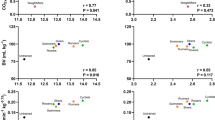Summary
Exercise-induced cardiac hypertrophy has been associated with normal resting left ventricula function and, after cessation of training, variable degrees of regression. The racing greyhound is as animal with cardiac hypertrophy said to be part congenital and part exercise-induced. Racing grcy hounds underwent serial cardiac catheterization three times during an 8-month period after cessation racing/training to determine the functional consequences of the cessation of training. At the end ci 8 months of inactivity the animals' hearts were excised and weighed in order to compare heart weight body weight (HW/BW) ratios with those obtained in a group of racing greyhounds killed within one month, 19±16 days (mean±SD), of the cessation of training. Comparison of HW/BW ratios failed to reveal a significant difference between the serially studied group, 12.1±1.9 g/kg (mean±SD), and the more recently exercising group, 12.7±1.4 g/kg (mean±SD) of dogs. After 2 months of inactivity, 9 ol 12 greyhounds in the serially studied group showed increases in max dP/dt and dP/dt normalized to pressure of 50 mm Hg. Modified pre-ejection period and peak negative dP/dt also increased significantly (p<.004) during this same period. No further changes in these variables were found at the final 8-month study. Our failure to demonstrate a difference in HW/BW ratios between these two groups or dogs suggests that the exercise-induced component of cardiac hypertrophy in the trained racing greyhound is probably very small and, if it exists, regresses very carly (<1 month). Changes in contractility indices that were observed occurred after this time period (between 1 and 2 months) and are therefore probably not due to regression of cardiac hypertrophy.
Similar content being viewed by others
References
Wikman-Coffelt J, Parmley WW, Mason DT (1979) The cardiac hypertrophy process. Analyses of factors determining pathological vs. physiological development. Circ Res 45:697–707
Crews J, Aldinger EE (1967) Effect of chronic exercise on myocardial function. Am Heart J 74:536–542
Ljungqvist A, Unge G (1972) The finer intramyocardial vasculature in various forms of experimental cardiac hypertrophy. Acta Path Microbiol Sand Section A 80:329–340
Wyatt HL, Mitchell JH (1974) Influences of physical training on the heart of dogs. Circ Res 35:883–889
Meerson FZ (1969) Introduction. Circ Res 24/25 (Suppl II) 1–8
Carew TE, Covell JW (1978) Left ventricular function in exercise-induced hypertrophy in dogs. Am J Cardiol 42:82–88
Nishimura T, Yamada Y, Kawai C (1980) Echocardiographic evaluation of longterm effects of exercise on left ventricular hypertrophy and function in professional bicyclists. Circulation 61:832–840
Badeer H (1964) Biological significance of cardiac hypertrophy (edit). Am J Cardiol 14:133–138
Baxley WA, Dodge HT (1971) Relationship of left ventricular performance and hypertrophy in humans. In: Cardiac Hypertrophy, edited by NR Alpert. New York, Academic Press, pp 425–431
Kennedy JW, Twiss RD, Blackman JR, Merendino KA (1968) Hemodynamic studies one year after homograft aortic valve replacement circulation 37/38 (Suppl II) 110–113
Schwartz F, Flameng W, Langebartels F, Sesto M, Walter P, Schlepper M (1979) Impaired left ventricular function in chronic aortic valve disease, survival and function after replacement by Bjork-Shiley prosthesis. Circulation 60:48–58
Papadimitriou JM, Hopkins BE, Taylor RR (1974) Regression of left ventricular dilation and hypertrophy after removal of volume overload. Morphological and ultrastructural study. Circ Res 35:127–135
Beznak M, Korecky B, Thomas G (1969) Regression of cardiac hypertrophies of various origin. Can J Physiol Pharmacol 47:579–586
Leon AS, Bloor CM (1968) Effects of exercise and its cessation on the heart and its blood supply. J Appl Physiol 24:485–490
Hickson RC, Holloszy JO (1977) Time course of regression of cardiac hypertrophy following cessation of endurance training (abstr). Med Sci Sport 9:55
Morganroth J, Maron BJ, Henry WL, Epstein SE (1975) Comparative left ventricular dimensions in trained athletes. Ann Intern Med 82:521–524
Roeske WR, O'Rourke RA, Klein A, Leopold G, Karliner JS (1976) Noninvasive evaluation of ventricular hypertrophy in professional athletes. Circulation 53:286–291
Ehsani AA, Hagberg JM, Hickson RC (1978) Rapid changes in left ventricular dimensions and mass in response to physical conditioning and deconditioning. Am J Cardiol 42:52–56
Beckner GL, Winsor T (1954) Cardiovascular adaptations to prolonged physical effort. Circulation 9:835–846
Polednak AP (1972) Longevity and cause of death among Harvard College athletes and their classmates. Geriatrics 27:53–64
Holmgren A, Standell T (1959) The relationship between heart volume, total hemoglobin and physical working capacity in former athletes. Acta Med Scand 163:149–160
Rippe JM, Pape LA, Alpert JS, Ockene IS, Paraskos JA, Kotalainen P, Anas J, Webster W (1982) Studies of systolic mechanics and diastolic behavior of the left ventricle in the trained racing greyhound. Basic Res Cardiol 77:619–644
Karliner JS, Gault HJ, Eckberg D, Mullins CB, Ross J (1971) Mean velocity of fiber shortening. A simplified measure of left ventricular contractility. Circulation 44:323–333
Grossman W, Jones D, McLavin LP (1975) Wall stress and patterns of hypertrophy in the human left ventricle. J Clin Invest 56:56–64
Spear KL, Koerner JE, Terjung RL (1978) Coronary blood flow in physically trained rats. Cardiovasc Res 12:135–143
Herrmann GR (1925) Experimental heart disease. Am Heart J 1:213–231
Herrmann GR (1926) The heart of the racing greyhound. Hypertrophy of the heart. Proc Soc Exper Bio Med 23:856–857
Schneider HP, Trvex RC, Knowles JO (1964) Comparative observations of the hearts of mongrel and greyhound dogs. Ant Rec 149:173–180
Steel JD, Taylor RI, Davis PE, Stewart GA, Salmon PW (1976) Relationship between heart score, heart weight and body weight in greyhound dogs. Australian Vet J 52:561–564
Cox RH, Peterson LH, Detweiler DK (1976) Comparison of arterial hemodynamics in the mongrel dog and the racing greyhound. Am J Physiol 230:211–218
DeSchryver C, Mertens-Strythagen J, Becsei I, Lammerant J (1969) Effect of training on heart and skeletal muscle catecholamine concentration in rats. Am J Physiol 217:1589–1592
Author information
Authors and Affiliations
Rights and permissions
About this article
Cite this article
Pape, L.A., Rippe, J.M., Walker, W.S. et al. Effects of the cessation of training on left ventricular function in the racing greyhound. Basic Res Cardiol 79, 98–109 (1984). https://doi.org/10.1007/BF01935812
Received:
Issue Date:
DOI: https://doi.org/10.1007/BF01935812




